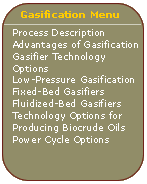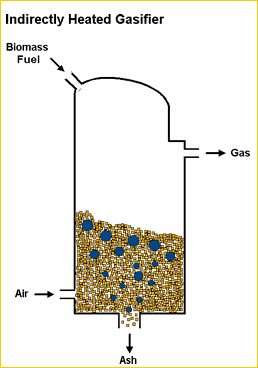



Technologies - Gasification
Fluidized-Bed Gasifiers
In a fluidized-bed gasifier, a continuous feed of biomass and inert heat-distributing material (i.e. sand) is "fluidized" by an oxidant and/or steam. There are two options for the way in which heat is supplied to the gasifier.In a directly heated fluidized-bed gasifier, heat required for gasification comes from char combustion in the gasifier reactor.

In an indirectly heated fluidized bed gasifier, char is removed from the gasifier and burned in a separate vessel. The resulting heat is transferred to the gasifier by either in-bed heat exchangers or by recirculating the inert bed material heated in the char combustor. The advantage of indirect heating is that gasification product is not diluted with the char combustion by-products.
In either design, pyrolysis takes place throughout the bed and is not localized. Because the injected air prevents the ash from melting, steam injection is not always required. As in the fixed-bed design, the product gas is drawn from the top of the gasifier. The superior mixing which occurs in the fluidized-bed generates excellent heat and mass transfer which subsequently yield uniform temperatures, better fuel-moisture utilization (fuel moisture to keep bed temperatures below the ash melting temperatures), and faster reactions. These benefits allow higher throughput capabilities which, in turn, can reduce the size and capital cost of the gasifier. Also, although the peak temperatures are lower, the average temperature in a fluidized-bed is greater than in a fixed-bed. A significant amount of tars and oils are converted into permanent gases.
Product gas composition, carbon efficiency, and hot gas efficiency for the fluidized-bed process are comparable to those found in the fixed-bed designs. Fluidized-bed designs, however, are capable of handling much smaller, less dense, and less uniform feedstocks. In fact, the fuel and fuel handling systems are more likely to set the lower limits for the acceptable bulk density. A shortcoming of the fluidized-bed design is the high particulate level in the raw gas.